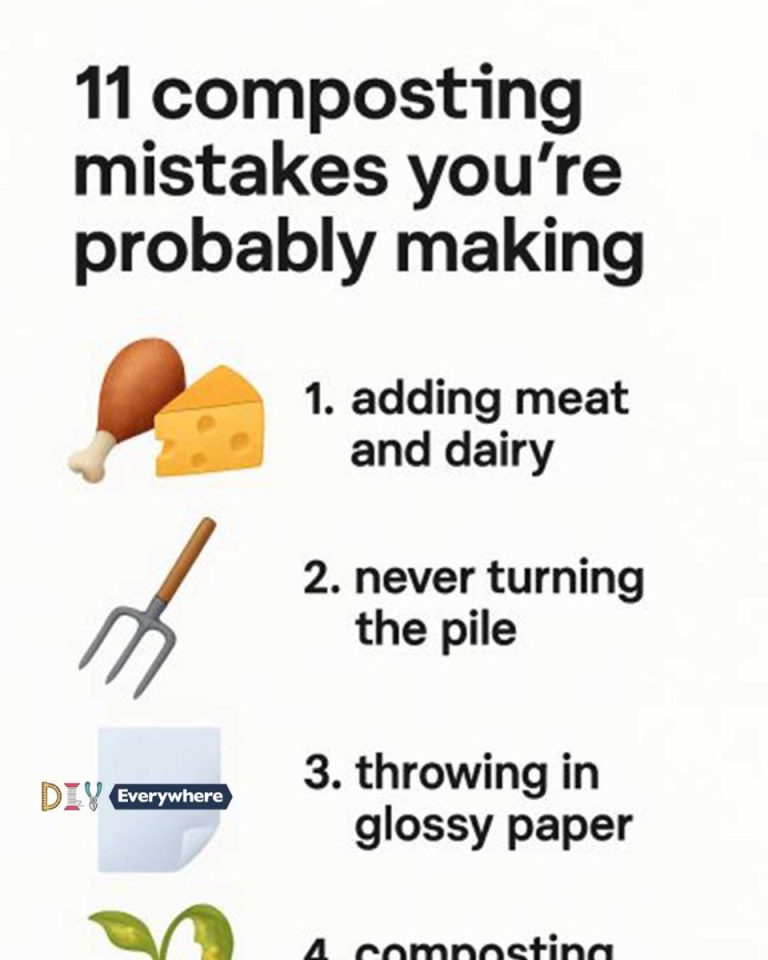11 composting mistakes you’re probably making

1. Adding Meat and Dairy
One of the most common mistakes in composting is adding meat and dairy products to your pile. These items don't break down as easily as plant-based materials and can lead to unpleasant odors and attract pests such as rodents and flies. In addition, meat and dairy can introduce pathogens to your compost, especially if the pile doesn't reach high enough temperatures to kill them off.
Instead, stick to vegetable scraps, fruit peels, coffee grounds, and eggshells. These materials break down more efficiently and help create a balanced compost. Keep your compost pile's temperature between 135°F to 160°F to ensure any harmful bacteria are eliminated.
2. Never Turning the Pile
A compost pile needs oxygen to decompose effectively. Failing to turn the pile regularly can lead to anaerobic conditions, which cause unpleasant smells and slow down the composting process. Aim to turn your compost pile every 1 to 2 weeks using a pitchfork or compost aerator.
Turning the pile helps distribute moisture and heat evenly throughout the compost, promoting faster decomposition. Regular mixing also helps prevent the growth of anaerobic bacteria, which thrive in the absence of oxygen and produce a foul odor.
3. Throwing in Glossy Paper
While paper products can be composted, glossy paper, such as magazines or certain types of junk mail, should be avoided. These papers often contain inks and coatings that do not break down easily and may introduce toxins into your compost.
Instead, opt for uncoated, non-glossy paper such as newspaper or brown paper bags. Shred them into small pieces to speed up the decomposition process. If in doubt, it's better to recycle glossy paper than to risk contaminating your compost.
4. Composting Diseased Plants
Adding diseased plants to your compost pile can introduce pathogens that might survive the composting process and infect future plants. This is especially problematic if your compost doesn't reach the high temperatures needed to kill off plant diseases.
To prevent this, avoid adding any plants that show signs of disease to your compost. If you're dealing with a diseased plant, it's safer to dispose of it in the trash or through municipal waste services rather than risk contaminating your entire compost pile.
5. Overwatering Your Compost
Moisture is essential for composting, but too much water can create a soggy pile that lacks the necessary oxygen for decomposition. Overwatering can lead to anaerobic conditions, causing unpleasant odors and slowing down the breakdown process.
To maintain the right moisture level, aim for your compost to have the consistency of a wrung-out sponge. If you squeeze a handful of compost and water drips out, it's too wet. Add dry materials like straw, leaves, or newspaper to absorb excess moisture.
6. Ignoring the Carbon to Nitrogen Ratio
The balance between carbon-rich 'browns' and nitrogen-rich 'greens' is crucial for successful composting. An imbalance can lead to a slow decomposition process or a smelly pile. A good rule of thumb is to aim for a ratio of 30 parts carbon to 1 part nitrogen by weight.
Carbon-rich materials include dried leaves, straw, and wood chips, while nitrogen-rich materials are typically kitchen scraps, grass clippings, and coffee grounds. Adjust the mix as needed to maintain this balance, which will help your compost break down efficiently and reduce odors.
7. Using Treated Wood Shavings
Treated wood contains chemicals that can leach into your compost, potentially harming beneficial microorganisms and plants. These chemicals can persist in the soil long after composting, affecting plant growth and health.
Instead, use untreated wood shavings or sawdust, preferably from hardwoods, as they break down more slowly and help aerate the compost. Always check the source of your wood shavings to ensure they haven't been treated with chemicals.
8. Composting Pet Waste
While it might seem like a good idea to compost pet waste, it's generally not recommended due to the risk of pathogens and parasites that can be harmful to humans. Cat and dog feces, in particular, can contain harmful bacteria and parasites that aren't killed by typical backyard composting methods.
If you want to compost pet waste, consider using a specialized pet waste composter or ensure your compost pile reaches temperatures above 145°F for several days to kill harmful pathogens. Otherwise, it's safer to dispose of pet waste through designated municipal waste systems.
9. Not Shredding Large Pieces
Large pieces of organic material take longer to break down, slowing the overall composting process. If you add large branches, whole vegetables, or big chunks of food waste, your compost pile will take much longer to decompose.
To speed up the process, break down large items before adding them to your compost. Chop branches into smaller pieces, shred cardboard and paper, and cut up kitchen scraps. This increased surface area helps microorganisms break down the material more efficiently.
10. Leaving Compost Exposed to Pests
An open compost pile can attract a variety of pests, including rodents, raccoons, and insects. These pests can disturb the composting process and potentially spread disease.
To prevent pest issues, ensure your compost bin is securely covered and has a lid that fits tightly. If you're using an open pile, consider adding a layer of wire mesh around it. Avoid adding food items that are known to attract pests, like meat, dairy, and cooked foods.
11. Failing to Monitor Temperature
Temperature is a key indicator of your compost's health and progress. A well-managed compost pile should have a core temperature between 135°F to 160°F to ensure effective decomposition and pathogen control.